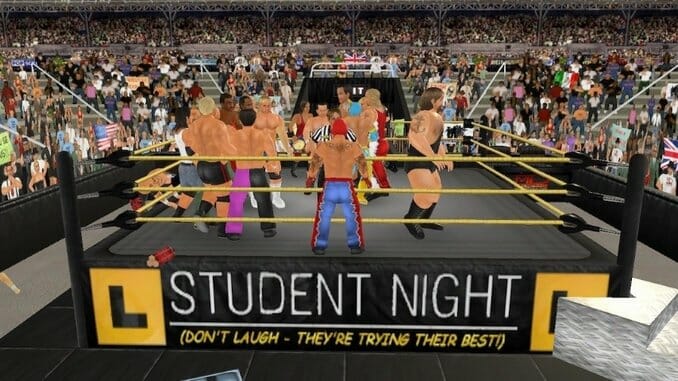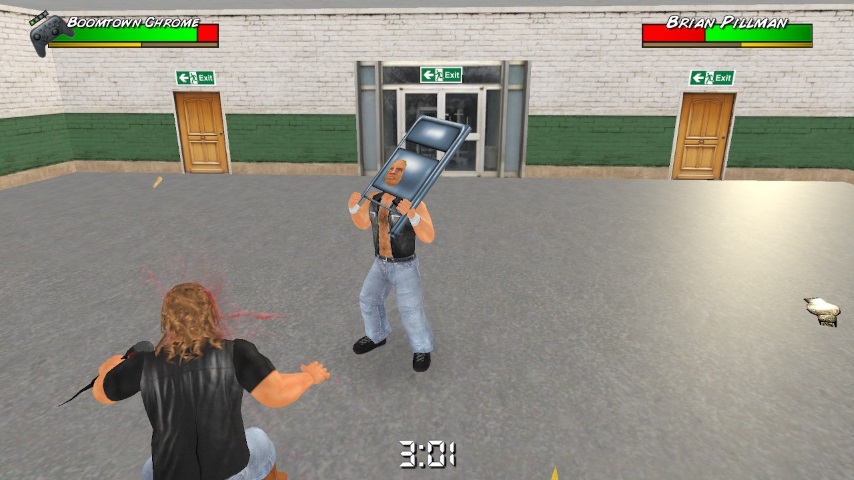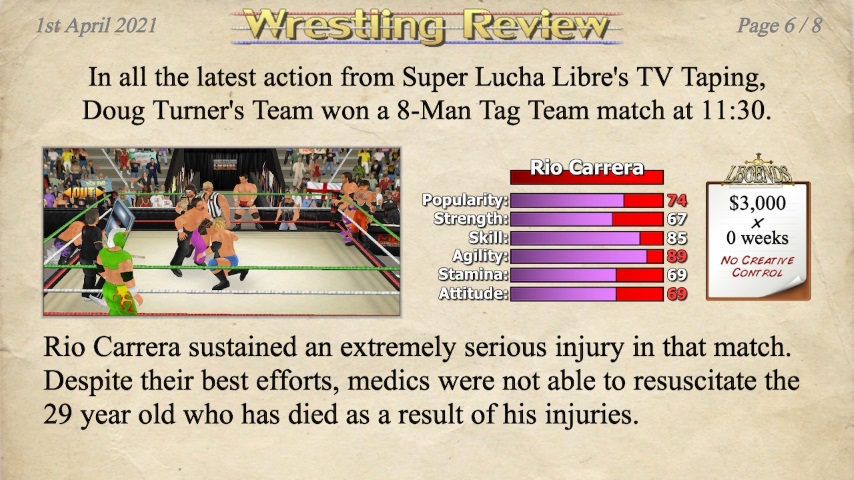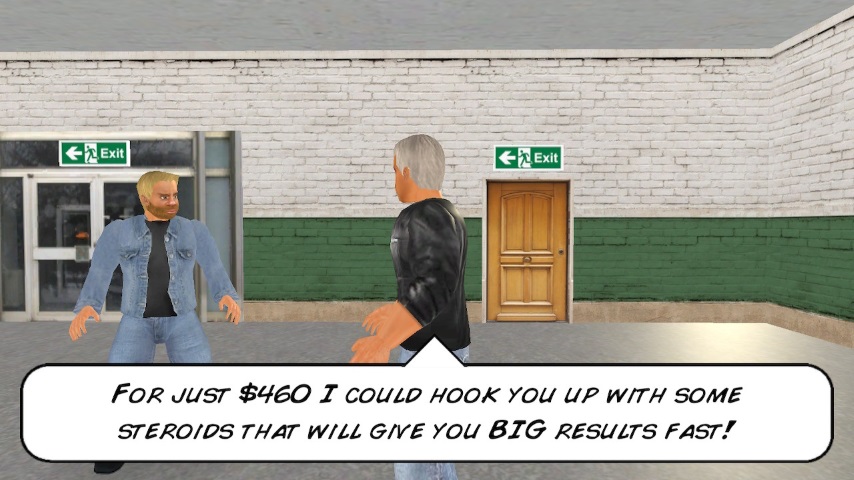The Gloriously Unhinged and Unpredictable Wrestling Empire Makes Wrestling Games Fun Again
Games Features wrestling empire
These are dark times for fans of wrestling games. WWE’s annual games have been a trainwreck for years—so much so that 2020 was the first year the series skipped this century (although a cartoony brawler was released in its place). Upstart rival AEW is still a ways off from releasing the games it announced back in November. And sure, Fire Pro Wrestling World is fantastic, but it’s a few years old now, and as great as Fire Pro games are, they’ve always been a bit of an acquired taste for American fans. The well has been so dry for so long that many wrestling fans still default back to the classic AKI games released over 20 years ago for the Nintendo 64, including WCW/nWo Revenge and WWF No Mercy.
Fortunately there’s a new wrestling game that aspires to the heights of those N64 classic N64s. Wrestling Empire, released earlier this month for the Switch, takes clear inspiration from them, both in how it looks and how it plays. Its massive roster, made up primarily of fictional characters who are very thinly disguised riffs on real wrestlers, recalls the heyday of the Fire Pro series. Wrestling Empire combines elements of the two most acclaimed wrestling game franchises, and then adds in a long, detailed career story mode that touches on issues both inside and outside the business that no other wrestling game would ever get near. All told, it’s a remarkably ambitious game.
It’s also completely incompetent. But fortunately, in the best possible way.
One man made Wrestling Empire. One single guy put this whole thing together. And if you’re familiar with the online hinterlands of wrestling videogames, it’s a name you probably know well.
Mat Dickie, known professionally as MDickie, has been making wrestling (and wrestling-inspired) games for over 20 years. Since he was a teenager he’s released dozens of games that are charmingly awkward and utterly ambivalent towards copyright laws. Wrestling Empire is a culmination of everything he’s done and learned in that time, and it is an absolutely glorious trainwreck.

The things I’ve seen during my time with Wrestling Empire would seem ridiculous even for wrestling promotions like DDT or Chikara. Almost every match starts with the referee grabbing a chair or other weapon when the bell rings, and they’ll randomly drop it and pick it back up again throughout the match. Managers, valets, and even the announcers routinely do wrestling moves outside the ring onto nobody, often climbing the guardrails and belly flopping onto the floor with a moonsault. Anybody who’s ringside will storm the ring multiple times during a match, but are apparently very conscientious about disqualifications, and will never actually do anything once they’re in it. They’ll just crowd up the ring, making it hard to actually wrestle in. Sometimes they’ll just set up a table in the ring, for fun. Once, during a tag match, the announce table exploded out of nowhere as my partner walked by it; it knocked him to the ground, and the broken halves of the table were consumed by flames for minutes afterward. One of the announcers, who was clearly supposed to be Vince Russo, then spent the rest of the match moonsaulting off the guardrails.
I won a submission only cage match by countout. Okay, that’s something that could actually happen in WWE.
The storylines in the career mode are just as capricious. I started my career in a promotion that’s clearly based on WCW circa ‘98 and early ‘99. Venom is clearly Sting, Max Mullet is Lex Luger, Jay Enrico is a young Chris Jericho, multiple luchadors look like their real-life inspirations, and all four future Radicalz have obvious analogues—yes, even Chris Benoit, who appears under the name Crispin Noir. Somehow an El Gigante clone made it onto this roster, and that was my character’s first feud. I fought El Giantina almost every week and every show for months, winning all the time, whether it was a singles or tag match. And then, out of nowhere, company head “Derek Switchoff” (guess who he’s based on) told me I wasn’t working out and forced a new gimmick upon me. I was now going to be this fake WCW’s ripoff of the star of another promotion—somebody named Judgement Dave. It wasn’t until my character started wearing a leather vest and jeans that I realized that was supposed to be Sid Justice, or the guy I always knew as Sid Vicious.
During my time as this clone of a Sid Vicious clone I helped start a wrestling union. I was point blank told to start doing steroids by my boss. I was threatened with termination if I didn’t win a championship by the end of the month, in a game whose relationship with kayfabe is ever-shifting and unpredictable. Legitimate backstage fights seemed to happen every month. After one hard-fought match, a screen popped up to nonchalantly tell me that my opponent, who was clearly based on Juvy Guerrera, had suffered serious injuries and died during the match.
I wrestled a man to death.

That last part is probably in poor taste. Wrestling has seen far too many real life tragedies over the decades, and although you could argue that Wrestling Empire is simply trying to be realistic in including that possibility, the counter to that is the entire rest of the game, which is just egregiously, gleefully absurd and unrealistic. The death of Fake Juvy legitimately put me in a sour mood, coming so soon after the latest untimely passing of a wrestling great. Of course we’ve now seen multiple wrestling promotions “kill off” characters whose performers are still alive and healthy, from Chikara to Lucha Underground to Impact, so maybe I’m just too sensitive. Hell, in the last year even WWE has explicitly advertised matches around the idea of ripping out eyeballs, burning opponents to a crisp in the middle of the ring, and throwing wrestlers off the top of the company’s eight story headquarters, so at this point a goofy, tongue-in-cheek videogame referring to wrestler deaths is actually pretty reserved compared to the places that the wrestling industry itself is willing go.
To his credit, Dickie openly acknowledges the, um, bizarre dream logic at the heart of Wrestling Empire. His Facebook page declares that he’s “celebrating 20 years of the ‘worst’ games to ever be enjoyed by millions of people.” He knows his rep, and he makes no bones about it—what could people possibly expect when one man tries to capture the spirit of games that are built by large teams of developers? There’s bound to be a bit of lo-fi roughness around the edges, and perhaps the best way to handle that is to fully embrace that awkwardness and make it one of the game’s defining features. That’s the tack Dickie has taken, and it’s largely worked out for him: people are wildly into his “so bad they’re good” games, treating them almost like the wrestling game equivalent of outsider art.

As much as people love to focus on the silliness of Wrestling Empire, they wouldn’t be able to play it long enough to experience it if Dickie hadn’t created a legitimately good foundation for a wrestling game. His easy, accessible, intuitive control scheme is something that should be replicated by every wrestling game going forward. If you want to climb anything—a turnbuckle, a table, the guardrails, even through the stands—you simply have to press the joystick in that direction. The grappling is strongly reminiscent of those old AKI games, but with the kinds of updates and revisions you’d expect 20 years later, with more moves and more ways to apply them. The basics all make sense in an almost elegant way, which can’t be said for WWE’s annual games, which somehow seem to grow worse and more unnecessarily complex every year. There’s a long list of features that would need to be refined to make Wrestling Empire actually great and not just a very fun, very ridiculous curiosity, but some of its fundamentals are rock solid.
There’s been an eternal debate within pro wrestling about how realistic the art needs to be. There’s a maxim that every generation of wrestlers thinks the next generation doesn’t know how to work—Lou Thesz thought Harley Race’s vertical suplex was too flashy and unrealistic, and now, 50 years later, today’s wrestling makes Harley Race’s era look impossibly slow and methodical. The best modern wrestling takes the realistic psychology and character work that has always worked in the past and injects it with the improbably fast-paced and athletic routines pioneered on the independent scene over the last two decades. Even the most psychologically sound of those matches still anger some of the old guard, though, who dismiss the high-flying, acrobatic work of performers like the Young Bucks and Kenny Omega as “videogame wrestling.” Wrestling Empire is what grumpy oldtimers like Jim Cornette, whose personal obsessions and inflexible opinions have made blind to the intricacies of modern wrestling, are thinking of when they bash the AEWs and Pro Wrestling Guerillas of the world. It’s wrestling with no subtlety, no sense, and an endless supply of joyous absurdity, and despite its blazingly obvious problems, it’s still about as infectiously fun as videogames get.
Senior editor Garrett Martin writes about videogames, comedy, music, travel, theme parks, wrestling, and anything else that gets in his way. He’s on Twitter @grmartin.